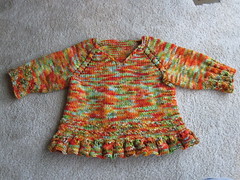Here's a little pattern I worked up last weekend. I don't know if my notes are clear enough for someone else to follow. If you knit this, please feel free to send me comments either here or on Ravelry.com. I'd love to hear what you think. I plan to add pictures as soon as I can.
These socks fit an average woman's foot. You could use DK weight and decrease your spi to make them fit men.
Materials:
I used one 2oz ball of fingering/sock weight yarn and size 2 needles, both 9" circ and DPNs.
Also needed: stitch markers, stitch holders or spare DPNs to use as holders, tapestry needle.
gauge:
7 stitches per inch in stockinette stitch
cast on:
co 38 with the long-tail method.
ankle:
R1: sl1, P6, sl1, P to end
R2: sl1 K6 sl1 (K1, sl1) until there are 7 stitches left, k7
Repeat R1-2 until 12 rounds total.
heel:
Place first 7 and last 7 stitches on holders.
continue heel piece in (sl1, K1) pattern as above until a total of 15 rounds or 30 rows have been knit.
turn heel:
Turn heel (P14, P2tog, P1, turn, ETC.) until 14 stitches remain. For a quick tutorial on how to do this, look here. Since this is a standard technique, I didn't write it all out. What can I say? I'm lazy sometimes.
constructing the arch section:
R1: pick up+ 9 stitches along side of heel flap, K1 stitch off holding needle, slip previous stitch over this stitch knitted off the holder (the last stitch picked up on side of heel.) turn.
R2: sl1, P to top edge of heel flap (9+14 stitches) pick up 9 stitches along other side of heel. K1 stitch from holding needle, slip previous stitch over as before.
R3: sl1, K to 1 st before holding needle, sl1, K1 from holder, psso. turn.
R4: sl1, P to 1 st before holdling needle, sl1, P1 from holder, Psso. Turn.
Repeat R3 and R4 until all but one stitch has been removed from holder.
complete R3 again but instead of turning, pick up 6 stitches along the edge of the ankle piece knit with the initial 12 rows. turn.
(K1, P1) 3 times, P to last stitch on needle and complete this row as R4 above. DO NOT TURN. Pick up 6 stitches along the edge of the ankle piece, turn.
(K1, P1) 3 times. K to last 6 stitches, (p1, K1) 3 times. CO 13 stitches and join in the round with ribbed section on opposite side of the ankle, placing a round marker.
Working in the round:
R1: (K1, P1) 3 times, K to ribbing, (P1,K1) three times, continue ribbing pattern across to end of round.
R2: (K1, P1) 3 times, place marker, K1, ssk, K to 3 stitches before ribbing begins, K2tog, K1, place marker, (P1,K1) ribbing to end of round.
Repeat R1-R3 until 49 stitches remain in total. Yes, 49. You cast on 13 stitches across the top of the foot to keep in K1P1 pattern so it's uneven. Now you'll remove the asymmetry by K2tog once at the center of the bottom of the foot, roughly 12 stitches from the ribbing section.
Continue in pattern until sock measures 2” less than desired length.
Toe decreases:
one row of K and then decrease as standard and kitchener graft to seam up.
If you don't know how to do this, read on!
You will want to switch to your DPNs now. Place a marker on either side of the ribbing. Now remember, you have 25 stitches in ribbing pattern and 23 stitches in stockinette. You'll want to place your markers just slightly off so that you have 24 st between each marker. Designate one of these markers the round marker.
R1: K
R2: K1, ssk, K to 3 stitches before marker, K2tog, K1, sm, ssk, K to 3 stitches before marker, K2tog, K1.
R3: K
Repeate R2-3 until 8 stitches remain between each marker, a total of 16 stitches in total.
Use a kitchener graft to close up the toe.
DONE!
The story behind this pattern is this: My family and I were perusing a local yarn shop a few weeks ago just for fun and my husband saw a pattern for socks similar to the above. He said, "You should make some of those for yourself!" I wasn't sure if I'd like them or not so I didn't want to spend the money on the pattern.
Fast forward to this past weekend when we were on a road trip. I had packed a sock project to work on and thought that was all I'd need. Lo and behold, my husband decided he didn't want me to use the yarn I had with me to make a gift for someone else ("It's too nice, you should make yourself something with it." See? He's always looking out for me because he knows I don't make much for myself.) So suddenly I had a 10 hour car trip and no busy work! We stopped at Hobby Lobby and picked up a ball of sock yarn and I decided I'd take a stab at something like the sock pattern we'd looked at a few weeks prior.
The pattern above is the result. I wasn't sure I'd like them still, even when I had them done! Until I wore them with my crocks. LOVE!




